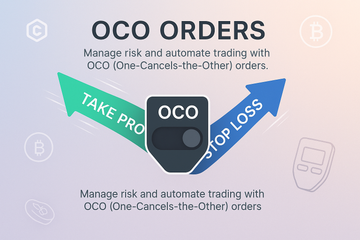Sometimes, crypto markets move faster than your morning coffee kicks in. Orders get eaten up, prices swing wildly, and if you blink, your well-planned strategy can turn upside down. So, how do traders keep calm and stay one step ahead? Enter the One-Cancels-The-Other (OCO) order—a neat little trick that savvy traders swear by. If you’ve ever wished you could be in two places at once, an OCO order is your best shot at digital multitasking.
What’s the Deal with OCO Orders?
Let me explain: OCO stands for 'One-Cancels-The-Other.' Think of it as setting up two possible escape routes for your trade. Place a limit order to lock in profit at your dream price and a stop-loss order to bail out if things go south. Whichever order hits first? The other vanishes, almost like it never existed. It’s a hands-off commitment to decision-making, and honestly, who doesn’t appreciate that kind of backup plan in the wild world of crypto?
Why Do Crypto Folks Love OCO Orders So Much?
There’s a rhythm to crypto trading—sometimes pulsing and intense, sometimes smooth like jazz. OCO orders help you keep your groove, especially when your schedule isn’t lined up with the 24/7 global exchange marathon. Here’s why traders keep coming back to OCO orders:
- Efficient Risk Management: Forget about staring at charts all day. OCO orders let you define your risk upfront, so you can walk away from the screens without sweating it.
- No Drama, No Hesitation: Emotional trades? Never again. The system makes decisions for you, nixing the FOMO (fear of missing out) or panic-selling jitters.
- Speedy Execution: Volatility loves to show up uninvited. OCO swoops in, executing as soon as your target is reached or cut-off point is hit.
- Ideal for Any Market: Whether you’re trading Bitcoin on Binance, Ether on Kraken, or even dabbling with the latest meme coins, OCO orders have your back.
Honestly, the peace of mind alone is worth setting one up. Imagine getting on with your day—maybe go for a walk, cook dinner, or even catch up on The Mandalorian—while your strategy looks after itself.
How Does an OCO Order Actually Work? Paint Me a Picture
Let’s say you’re holding some Bitcoin you bought at $30,000. You’re thinking, “If it goes up to $32,000, I’ll happily take profit. But if it drops below $29,500, I want out before things get ugly.” Instead of picking just one outcome, you set both as conditional orders within an OCO order. If Bitcoin hits $32,000, your sale executes and your stop-loss order evaporates. But if the price tanks first, the stop-loss triggers and your profit order cancels. Simple, effective, and automatic—like a self-driving car for your portfolio (minus the sketchy software updates).
Trendy Use Cases: How Pro Traders Leverage OCO Orders
Now, plenty of traders anchor their strategies with OCO orders. Here’s how these get used daily:
- Breakout Hunters: OCOs are perfect for those targeting sharp moves after a price squeeze. Set your upside limit order near the breakout point, and a stop just below key support. Whichever the market chooses, you’re covered.
- Profit Preservation: Holding a plump gain? Use OCO to chase more upside while making sure to keep your winnings if things go the wrong way.
- Setting and Forgetting: Vacation mode, anyone? Lock in both directions and go live your life. Your crypto wallet—preferably stored in a reliable hardware wallet like a Trezor or Ledger—doesn’t need 24/7 surveillance.
Pro tip: Some users even layer OCO orders at different price ranges to slowly scale out of a big position. Like peeling off profits in slices—no rush, no stress.
OCO Orders in Real Life: Where Can You Use Them?
Most major exchanges offer OCO functionality, though the details can vary. On platforms like Binance or Crypto.com, the process is fairly polished: pick your orders, set your prices, and you’re good to go. Just be aware that on certain exchanges, especially in margin trading environments, advanced orders might not always be supported; always check the fine print.
For hardware wallet enthusiasts—think Trezor and Ledger fans—it’s important to remember: the OCO magic happens at the exchange level. Your hardware wallet secures your long-term holdings, but once you move assets onto an exchange for trading, OCO orders can keep your active positions agile and safe. Hardware wallets and order automation? That’s a modern security duo if ever there was one.
What Should You Watch Out For?
You know what? OCOs aren’t foolproof. Here’s the not-so-fine print:
- Execution Isn’t Guaranteed: In thinly traded markets or during wild price swings, the order left standing after a trigger might not fill at your chosen price.
- Manual Cancellations: If you change your mind on the fly, you’ll need to manually cancel the OCO pair. Forgetting? That’s a classic rookie mistake.
- Platform Quirks: Each exchange’s OCO tools work a little differently. Sometimes the user interface isn’t intuitive, or advanced features are restricted by region.
As always in crypto, test on a demo account or with small amounts first. It’s better to make minor errors with pocket change than with your hard-earned stack.
OCO Orders: The Final Word
The beauty of a One-Cancels-The-Other order is subtle. You get flexibility and automation, all while minimizing those emotional, late-night trading regrets. Seasoned traders know that the smartest move is often the one that lets their plan, not their impulses, make the call.
So, if you’re tired of watching your phone every time Bitcoin sneezes, maybe it’s time you gave OCO orders a try. Pair the power of automation with the safety of a hardware wallet like Trezor or Ledger, and you’ll be as chill as a cat on a sunny windowsill, no matter how wild the market gets. Ready to let your strategy trade for you? Now’s your moment to see how much smoother crypto trading can feel—when every path forward is already mapped out.











